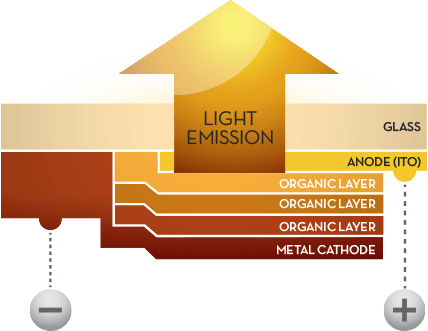
An OLED lighting panel starts with a transparent substrate that provides mechanical structure as well as desired optical properties. The substrate includes a patterned transparent conductor layer, usually Indium Tin Oxide (ITO) which serves as the bottom electrode, or anode. Very thin layers of organic materials are deposited onto the anode surface followed by a metallic cathode, or second electrode. These layers are very thin and each layer may contain several materials.
The choice of organic dopants determines the wavelength, or color, of the emitted light. The organic layers are unordered, which means, unlike LED, they do not require a crystalline substrate. Therefore, OLED lighting can be built on a wide variety of low cost substrates and across wide areas, making them ideal for large-area light sources.
When complete, the OLED is actually thinner than a human hair!
Benefits of OLED Lighting
- OLED lighting will introduce a paradigm shift in the way we think about lighting and the way we use it. For the first time, light will be generated naturally as areas of uniform soft emission rather than piercing points or tubes of light.
- OLED lights will light your world without shades, reflectors or diffusers. Bulky fixtures to hide light sources will become passé. The new OLED lighting will emphasize the architecture rather than clutter it.
- As a solid-state lighting technology, OLED technology is readily compatible with control, dimming and sensor systems.
- OLED lighting consume significantly less energy than standard lights.
- OLED white lights have a naturally broad spectrum and excellent light quality
- OLED lighting devices emit light from the surface. The lighting panel may be flexible and, potentially, even transparent like a window or a reflective mirror.
- OLED lighting is thin, durable and lightweight. The technology provides fast switch-on times, wide operating temperatures and no noise.
- OLED lighting contains no mercury, eliminating the disposal and pollution problems associated with fluorescent lighting.